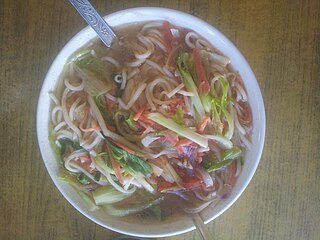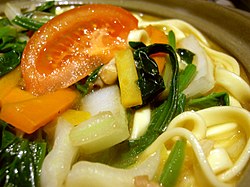
Chinese noodles vary widely according to the region of production, ingredients, shape or width, and manner of preparation. Noodles were invented in China, and are an essential ingredient and staple in Chinese cuisine. They are an important part of most regional cuisines within China, and other countries with sizable overseas Chinese populations. Chinese noodles can be made of wheat, buckwheat, rice, millet, oats, beans, potatoes, sweet potatoes, and even fish. There are over 1,200 types of noodles commonly consumed in China today, with many thousands of more noodle dishes prepared using these types of noodles.

Momo is a type of steamed filled dumpling that is a national dish of Nepal. It is also popular in Bhutan, Tibet and in the Indian region of Ladakh and the state of Sikkim. In Nepal, they are usually served with a sauce known as achar influenced by the spices and herbs used within many South Asian cuisines. It can also be cooked as soup versions known as Jhol Momo where the broth is made from achar using a mixture of tomatoes, sesame seeds, chillies, cumin and coriander to make or Mokthuk from boiling pork/buff bones mixing with various herbs and vegetables.

Banmian or pan mee is a popular Chinese noodle dish, consisting of handmade noodles served in soup. Other types of handmade noodles include youmian, or mee hoon kueh.

Czech cuisine has both influenced and been influenced by the cuisines of surrounding countries and nations. Many of the cakes and pastries that are popular in Central Europe originated within the Czech lands. Contemporary Czech cuisine is more meat-based than in previous periods; the current abundance of farmable meat has enriched its presence in regional cuisine. Traditionally, meat has been reserved for once-weekly consumption, typically on weekends.

Noodle soup refers to a variety of soups with noodles and other ingredients served in a light broth. Noodle soup is a common dish across East Asia, Southeast Asia and the Himalayan states of South Asia. Various types of noodles are used, such as rice noodles, wheat noodles and egg noodles.

Thukpa is a Tibetan noodle soup, which originated in the eastern part of Tibet. Amdo thukpa is a famous variant among the Indians, Tibetans and Nepalese. Thukpa can be prepared in both vegetarian and non-vegetarian variations; the most popular non-vegetarian variation includes chicken. There are numerous varieties of thukpa which includes:

Tatar cuisine is primarily the cuisine of the Volga Tatars, who live in Tatarstan, Russia, and surrounding areas.

Tibetan cuisine includes the culinary traditions and practices and its peoples. The cuisine reflects the Tibetan landscape of mountains and plateaus and includes influences from neighbors. It is known for its use of noodles, goat, yak, mutton, dumplings, cheese, butter, yogurt, and soups. Vegetarianism has been debated by religious practitioners since the 11th century but is not prevalent due to the difficulty of growing vegetables, and cultural traditions promoting consumption of meat.

Nepali cuisine comprises a variety of cuisines based upon ethnicity, alluvial soil and climate relating to Nepal's cultural diversity and geography. Dal-bhat-tarkari is eaten throughout Nepal. Dal is a soup made of lentils and spices, bhat — usually rice but sometimes another grain — and a vegetable curry, tarkari. Condiments are usually small amounts of spicy pickle which can be fresh or fermented, mainly of dried mustard greens and radish and of which there are many varieties. Other accompaniments may be sliced lemon (nibuwa) or lime (kagati) with fresh green chilli and a fried papad and also Islamic food items like rice pudding, sewai, biryani etc. Dhindo (ढिंडो) is a traditional food of Nepal. A typical example of Nepali cuisine is the Chaurasi Byanjan(Nepali: चौरासी व्यञ्जन) set where bhat(rice) is served in a giant leaf platter(Patravali) along with 84 different Nepali dishes each served on small plates.It is mostly fed during weddings and Pasni(rice feeding ceremony).

Chicken and dumplings is a soup that consists of a chicken cooked in water, with the resulting chicken broth being used to cook the dumplings by boiling. A dumpling—in this context—is a biscuit dough, which is a mixture of flour, shortening, and liquid. The dumplings are either rolled out flat, dropped, or formed into a ball.

Javanese cuisine is the cuisine of Javanese people, a major ethnic group in Indonesia, more precisely the province of Central Java, Yogyakarta and East Java.

Thukpa bhatuk is a common Tibetan cuisine noodle soup that includes small bhatsa noodles. This dish is a common soup made in the winter but is especially important for Tibetan New Year. On Nyi-Shu-Gu, the eve of Losar, the common Tibetan soup, thukpa bhatuk is made with special ingredients to form guthuk. Guthuk is then eaten on Losar to symbolise getting rid of negativities of the past year and invite positives into the new year.

Betawi cuisine is rich, diverse and eclectic, in part because the Betawi people that create them were composed from numbers of regional immigrants that came from various places in the Indonesian archipelago, as well as Chinese, Indian, Arab, and European traders, visitors and immigrants that were attracted to the port city of Batavia since centuries ago.

Dumpling is a broad class of dishes that consist of pieces of cooked dough, often wrapped around a filling. The dough can be based on bread, flour, buckwheat or potatoes, and it may be filled with meat, fish, tofu, cheese, vegetables, fruits or sweets. Dumplings may be prepared using a variety of cooking methods and are found in many world cuisines.

A wonton is a type of Chinese dumpling commonly found across regional styles of Chinese cuisine. It is also spelled wantan or wuntun in transliteration from Cantonese 雲吞 / 云吞 and wenden from Shanghainese 餛飩 / 馄饨. Even though there are many different styles of wonton served throughout China, Cantonese wontons are the most popular in the West due to the predominance of Cantonese restaurants overseas.

Indian Indonesian cuisine is characterized by the mixture of Indian cuisine with local Indonesian-style. This cuisine consists of adaptations of authentic dishes from India, as well as original creations inspired by the diverse food culture of Indonesia. Indian influence can be observed in Indonesia as early as the 4th century. Following the spread of Islam to Indonesia and trading, Muslim Indian as well as Arab influences made their way into Indonesian cuisine. Examples include Indian biryani, murtabak, curry and paratha that influenced Acehnese, Minangkabau, Malay, Palembangese, Betawi and Javanese cuisine.

Indonesian noodles are a significant aspect of Indonesian cuisine which is itself very diverse. Indonesian cuisine recognizes many types of noodles, with each region of the country often developing its own distinct recipes.

Mokthuk or Mothuk is a type of momo soup that is popular in Tibet, Nepal and Ladakh, a region in northern India. It's originates from Tibet that was created out of a combination of momo and thukpa where unlike the momos, the shape of the dumplings are usually smaller known as tsi-tsi momos.



















